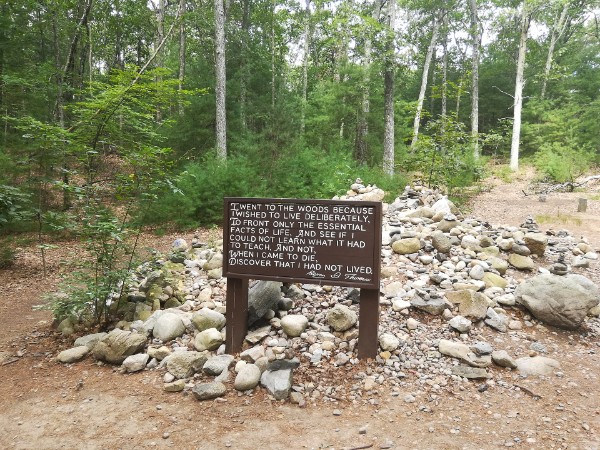As you can easily tell from my first name Hermione, my parents are huge fans of fantasy adventures. I also much liked the Harry Potter series, but for me personally, the Lord of the Rings is one of the greatest fantasy-adventures I know. I must have read the trilogy a hundred times and just couldn’t get enough when the movie series was released.
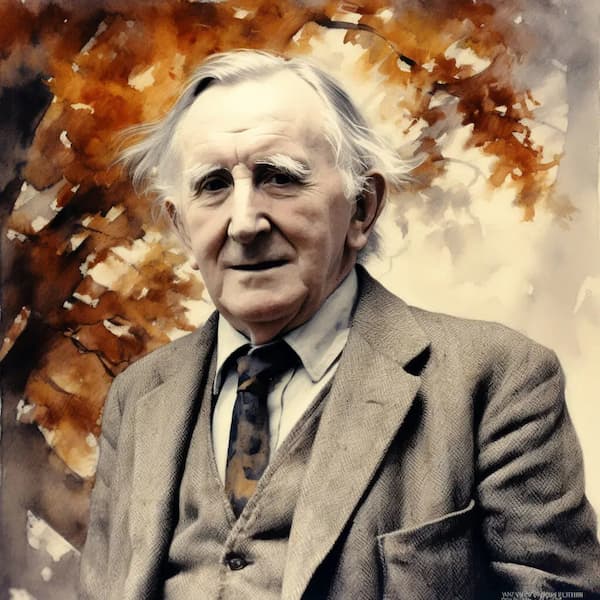
Portrait of J.R.R. Tolkien
As you know, the stories of The Hobbit and The Lord of the Rings come from the pen of John Ronald Reuel Tolkien, an English writer and philologist. He is affectionately called the “father of modern fantasy literature,” and since he was born on 3 January, that date has been officially designated J.R.R. Tolkien Day. What a great occasion to have a look around to see what kinds of musical imaginations Tolkien’s writing has inspired.
Howard Shore: Theme from Lord of the Rings
You probably know the music of Howard Shore, who composed, orchestrated, conducted and produced the music for The Lord of the Rings film series between 2000 and 2004. It’s a huge score, sounding many, many hours of music. Shore wanted the score to be operatic, and he looked towards Richard Wagner for his method.
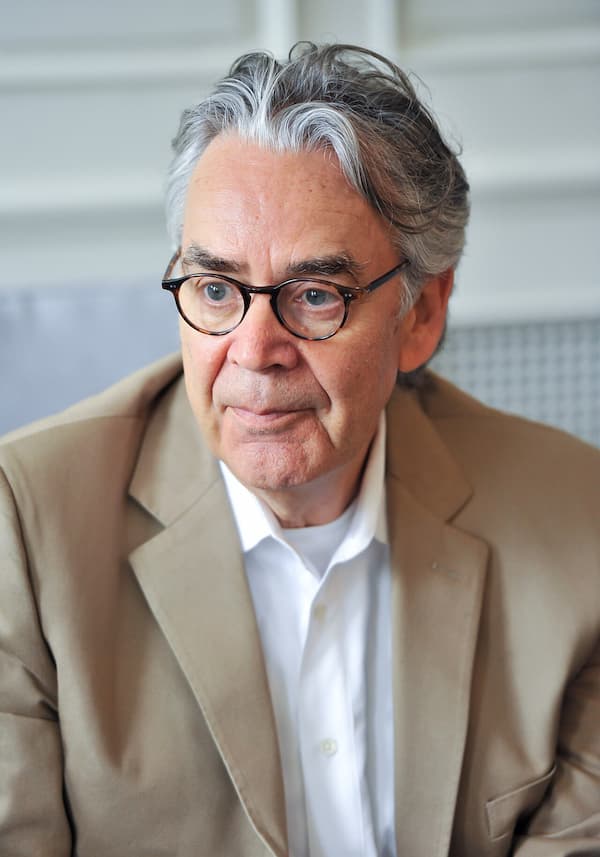
Howard Shore
Shore included as many as 110 leitmotifs to represent various characters, cultures and places. Some people claim that it is “the largest catalogue of leitmotifs in the history of cinema, surpassing, for comparison, that of the entire Star Wars film series.” He even outdid Wagner with the use of an immense ensemble, including a large symphony orchestra and multiple instruments bands and vocalists. It is impressive, and a listener poll voted the music the best soundtrack of all time for six years in a row.
Johan de Meij: Symphony No. 1, “The Lord of the Rings”
Johan de Meij: Symphony No. 1, “The Lord of the Rings” (Gandalf) (Quebec Wind and Percussion Ensemble; Rene Joly, cond.)
J.R.R Tolkien was a professor of English literature when he wrote his epic adventure, The Lord of the Rings. He was inspired by Celtic and Nordic legends and imagined a new mythology reminiscent of old England. This fictitious world, the Middle Earth, is full of hobbits, dwarfs, elves, monstrous creatures, and human beings. The story evokes the unending struggle between good and evil, with the Ring in the central role of deciding the survival or destruction of the world.
The Lord of the Rings novel is one of the best-selling books ever written, with over 150 million copies sold. One of these copies must have fallen into the hands of the Dutch conductor, trombonist, and composer Johan de Meij. His Symphony No. 1 for wind ensemble, nicknamed “The Lord of the Rings Symphony”, was a resounding success, and it premiered on 15 March 1988. Since then, it has been recorded by several orchestras.
Johan de Meij: Symphony No. 1, “The Lord of the Rings” (Lothlorien) (Quebec Wind and Percussion Ensemble; Rene Joly, cond.)
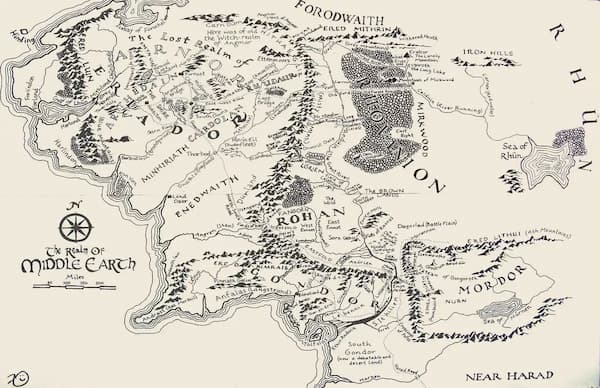
Map of the Middle Earth
I think it would be rather confusing trying to find all 110 leitmotifs in Howard Shore’s score; that is why I like the Johan de Meij score. Every movement of his symphony is titled so that we can musically meet the characters. The first movement is a musical portrait of the wizard Gandalf. He is basically charged with protecting the people of Middle Earth. It opens with a stately motive but quickly turns into a wild ride on the horse “Shadowfax,” and finishes with a majestic choral of Mithrandir.
In the second movement, we enter the Elvenwood with its beautiful trees, plants, and exotic birds. The music also details the meeting of the Hobbit Frodo with Lady Galadriel, the Queen of the Elves. When he looks in the magic mirror, he sees the master of the evil forces searching him out.
Johan de Meij: Symphony No. 1, “The Lord of the Rings” (Gollum) (Quebec Wind and Percussion Ensemble; Rene Joly, cond.)
The slimy character Gollum is represented by the soprano saxophone. He expresses his anger and sadness in a long lament, cursing the Hobbits for stealing the Ring. He pushes Frodo, the hobbit, into the web of the giant spider, Shelob. Frodo is saved by Sam Gamgee, and in the next scene, we find the characters in the realm of the Dark Lord, with Gollum falling to the bottom of the volcano.
You can already tell that the music is not following the storyline of the book, but jumps around a bit. “Journey in the Dark” finds the fellowship in the deep mines of Moria where they encounter Orcs, and Gandalf seemingly falls to his death during his fight with the Balrog of Moria.
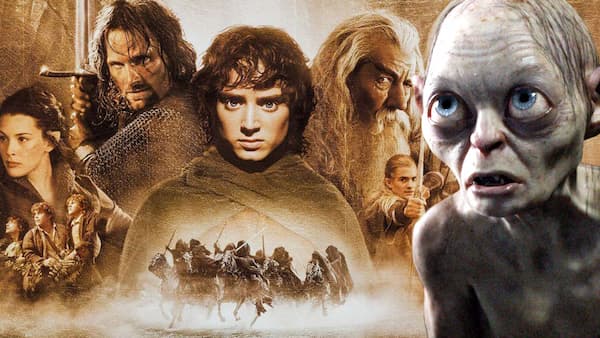
The Lord of the Rings film trilogy
Johan de Meij: Symphony No. 1, “The Lord of the Rings” (Journey in the Dark) (Quebec Wind and Percussion Ensemble; Rene Joly, cond.)
The concluding movement, “Hobbits”, finds them returning to Middle Earth. Their victory is complete as their land has been liberated from the invaders. A beautiful hymn describes the peaceful character, and Gandalf reappears to take Frodo to the land of the immortal gods.
Johan de Meij: Symphony No. 1, “The Lord of the Rings” (Hobbits) (Quebec Wind and Percussion Ensemble; Rene Joly, cond.)
Some composers are a little less explicit, for example, the composer and pianist John Alan Rose. He has received prizes at international music competitions and has crafted a very imaginative piano concerto subtitled “Tolkien Tale.” It is a programmatic fantasy with Eastern European folk elements and scored in three titled movements.
“Setting out on a great adventure” takes the listener on a fantastic journey into Middle Earth, resounding with pentatonic explorations, “perhaps in homage to the folk-inspired worlds by Bartók, Brahms, Dvořák, and Prokofiev. The second movement is a short interlude titled “Lullaby,” tenderly exploring the interaction between keyboard and woodwinds. It all concludes with a fanciful “March,” projecting a musical atmosphere of all the things encountered along the way.
John A. Rose: Piano Concerto, “Tolkien Tale”
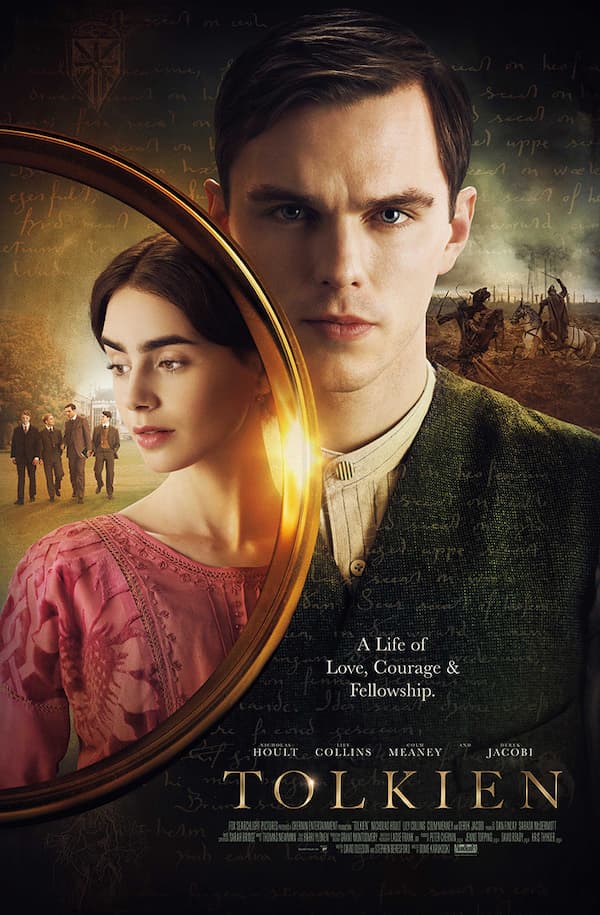
Tolkien (2019) movie poster
John A. Rose: Piano Concerto, “Tolkien Tale” (Moravian Philharmonic Orchestra; Miran Vaupotić, cond.)
You might know that J.R.R Tolkien himself has been the subject of cinematic treatment. In 2019, we saw the release of a biographical drama titled “Tolkien.” It’s a typical Hollywood storyline detailing a difficult financial childhood, a bully turned best friend, and his struggles at Oxford. The film also tells about Tolkien’s experiences in the war and his love story with Edith. The motion picture ends when Tolkien, now a professor at Oxford, writes the famous opening line of The Hobbit, “In a hole in the ground, there lived a hobbit.”
The music comes from American composer and conductor Thomas Newman, who likes to experiment with instrumentation. You will hear a whole range of unusual instruments and unusual sounds. As the composer once declared, “I have an interest in mundane experimentation.”
Thomas Newman: Tolkien
Thomas Newman: Tolkien (Grace Davidson, soprano; Phil Todd, flute/piccolo/recorder/pennywhistle; Sonia Slany, fiddle; George Doering, guitar/mandolin/dulcimer; Andrew Cronshaw, 12-string guitar; Nick Cooper, viola da gamba; Paul Clarvis, percussion; Thomas Bowes, cond.)
If you read The Lord of the Rings trilogy, you know that Tolkien included a number of illustrations, like maps of Middle Earth, and he also invented calligraphy written in Tengwar script to illustrate the Black Speech of Mordor. What makes this trilogy truly special, however, is that Tolkien included over 60 pieces of poetry.
The verses and songs appear in many different genres, including rhymes for marching, drinking, and having a bath. We also find ancient myths, riddles, prophecies, and laments. Literary scholars judge them to “be of high technical skill,” and some have been set to music as well. Maybe you have a special way of celebrating J.R.R. Tolkien Day on 3 January? For my part, I will binge-watch the complete “The Lord of the Rings” film series.
For more of the best in classical music, sign up for our E-Newsletter
Donald Swann: Bilbo’s Last Song
Donald Swann: Bilbo’s Last Song (John Amis, vocals; Donald Swann, piano)

